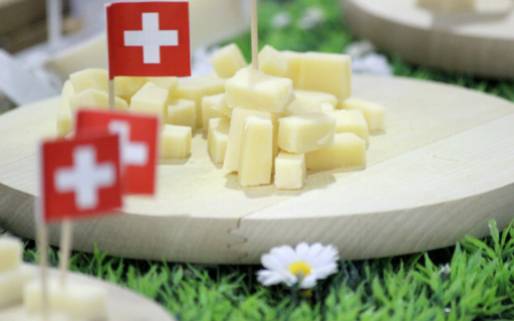Switzerland's famed Gruyère cheese is a beloved culinary treasure known for its rich, nutty flavor and creamy texture. The traditional cheese-making techniques used in the picturesque region of Gruyères have been passed down through generations, resulting in a product that embodies centuries of expertise and craftsmanship. From the initial curdling of milk to the meticulous aging process, each step in the production of Gruyère cheese plays a vital role in creating its distinctive taste and quality. Whether produced on a small scale by skilled artisans or through larger industrial operations, Gruyère cheese maintains a commitment to sustainability and tradition, ensuring that each wheel of cheese is a true reflection of Swiss craftsmanship.

Traditional Cheese-Making Techniques in Gruyères
The making of Gruyère cheese in the region of Gruyères involves traditional cheese-making techniques that have been passed down through generations. The process begins with high-quality milk from cows grazing on lush pastures in the Swiss Alps. The milk is heated and mixed with rennet to form curds, which are then cut and stirred to release whey. The curds are then pressed into molds and left to drain, forming the iconic wheel shape of Gruyère cheese. The wheels are then bathed in a salt brine solution and aged in cool, humid caves for several months to develop their distinct flavors and textures. This traditional method of cheese-making in Gruyères ensures that each wheel of Gruyère cheese is of the highest quality and flavor, making it a sought-after delicacy worldwide.
Aging Process: From Curd to Wheel
During this time, the curds begin to release whey and continue to develop their flavor. After the resting period, the curds are transferred into molds where they are pressed to remove any excess whey and shape them into the iconic wheel of Gruyère cheese.
The newly formed wheels of cheese are then soaked in a brine solution to help develop the rind and enhance the flavor. Following the brine bath, the wheels are moved to the aging caves where they will spend anywhere from 5 to 14 months maturing. During this time, the cheese wheels are regularly turned and brushed to evenly distribute the flavors and encourage the development of the desirable rind.
As the cheese ages, its flavor profile intensifies and becomes more complex. The aging process is crucial in the production of Gruyère cheese, as it allows the flavors to fully develop and creates the distinctive characteristics that make this cheese so prized. The result is a rich and nutty cheese with a slightly grainy texture that is beloved by cheese connoisseurs around the world.
Artisanal vs. Industrial Production of Gruyère Cheese
Artisanal vs. Industrial Production of Gruyère Cheese
In the production of Gruyère cheese, there are two main methods that are utilized: artisanal and industrial production. The artisanal method of production involves traditional techniques that have been passed down through generations. Artisanal cheesemakers often use raw milk from local cows and follow a hands-on approach to crafting the cheese. This process typically involves smaller batches and a longer, more meticulous production timeline.
On the other hand, industrial production of Gruyère cheese involves larger-scale operations that utilize modern technology and machinery to streamline the cheese-making process. Industrial producers often use pasteurized milk from various sources and may incorporate additives or preservatives to achieve a consistent flavor profile. This method allows for mass production and distribution of Gruyère cheese to meet the high demand for this popular cheese.
Both artisanal and industrial production methods have their own advantages and drawbacks. Artisanal production is often praised for its commitment to tradition and quality, resulting in a cheese with unique flavors and characteristics. However, this method can be more time-consuming and labor-intensive, leading to higher production costs and limited accessibility.
Industrial production, on the other hand, allows for greater consistency in flavor and texture, as well as increased efficiency in production and distribution. This method enables Gruyère cheese to be more readily available to consumers around the world at a more affordable price point. However, some may argue that industrial production sacrifices the artistry and craftsmanship that is inherent in artisanal cheese-making.
Ultimately, both artisanal and industrial production methods play a crucial role in the production of Gruyère cheese, offering consumers a variety of options to choose from based on their preferences and values. Whether you prefer the artisanal charm of a handcrafted wheel of Gruyère or the convenience of a mass-produced block, the choice is yours to make.
Sustainability Practices in Gruyère Cheese Production
Gruyère cheese production in the region of Gruyères, Switzerland, is characterized by sustainability practices that prioritize environmental responsibility and the well-being of both the cows and the local community. One key aspect of sustainability in Gruyère cheese production is the use of high-quality, locally sourced milk from cows that graze on natural pastures. This not only ensures the superior taste and quality of the cheese but also supports the local agricultural economy.
Furthermore, many cheese-making facilities in Gruyères implement energy-efficient practices to reduce their carbon footprint. This includes using renewable energy sources, such as hydropower, and optimizing production processes to minimize waste and energy consumption. Additionally, some producers have invested in eco-friendly packaging materials and transportation methods to further reduce their environmental impact.
In terms of animal welfare, Gruyère cheese producers adhere to strict regulations regarding the treatment of cows. The cows are given access to outdoor grazing areas and are not subjected to any unnecessary stress or discomfort during the milking process. This ensures that the cows are healthy and happy, which ultimately contributes to the high quality of the milk used to make Gruyère cheese.
Overall, sustainability practices in Gruyère cheese production are a testament to the region's commitment to preserving traditional cheese-making techniques while also embracing modern methods that prioritize environmental conservation and ethical treatment of animals. By implementing these practices, Gruyères continues to produce some of the finest, most sustainable cheeses in the world.
